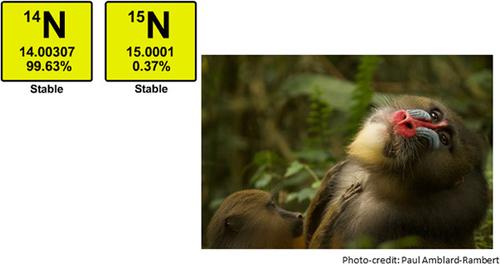当前位置:
X-MOL 学术
›
Am. J. Primatol.
›
论文详情
Our official English website, www.x-mol.net, welcomes your feedback! (Note: you will need to create a separate account there.)
Seasonality and interindividual variation in mandrill feeding ecology revealed by stable isotope analyses of hair and blood
American Journal of Primatology ( IF 2.4 ) Pub Date : 2020-10-19 , DOI: 10.1002/ajp.23206 Vicky M. Oelze 1, 2 , Alice M. Percher 3 , Gontran Nsi Akoué 4 , Nory El Ksabi 5 , Eric Willaume 5 , Marie J. E. Charpentier 3
American Journal of Primatology ( IF 2.4 ) Pub Date : 2020-10-19 , DOI: 10.1002/ajp.23206 Vicky M. Oelze 1, 2 , Alice M. Percher 3 , Gontran Nsi Akoué 4 , Nory El Ksabi 5 , Eric Willaume 5 , Marie J. E. Charpentier 3
Affiliation

|
Mandrills are large‐bodied terrestrial forest primates living in particularly large social groups of several hundred individuals. Following these groups in the wild to assess differences in diet over time as well as among individuals is demanding. We here use isotope analyses in blood and hair obtained during repeated captures of 43 identified free‐ranging mandrills (Mandrillus sphinx) from Southern Gabon, to test how dietary variation relates to the season as well as an individual's age and sex. We measured the stable carbon (δ13C‰) and nitrogen (δ15N‰) isotope ratios in 46 blood and 214 hair section samples as well as from a small selection of mandrill foods (n = 24). We found some seasonal isotopic effects, with lower δ13C values but higher δ15N values observed during the highly competitive long dry season compared to the fruit‐rich long rainy season. Variation in δ13C was further predicted by individual age, with higher δ13C values generally found in younger individuals suggesting that they may consume more high canopy fruit than older individuals, or that older individuals consume more low canopy foliage. The best predictor for δ15N values was the interaction between age and sex, with mature and reproductively active males revealing the highest δ15N values, despite the observation that males consume substantially less animal food items than females. We interpret high δ15N values in these mature male mandrill blood and hair sections to be the result of nutritional stress associated with intense male–male competition, particularly during mating season. This is the first study showing isotopic evidence for nutritional stress in a free‐ranging primate species and may spark further investigations into male mandrill diet and energy balance.
中文翻译:

稳定的头发和血液同位素分析显示山man饲喂生态系统的季节性和个体差异
山d是大地陆生的灵长类动物,生活在数百人的特别大的社会群体中。在野外跟随这些群体来评估随时间推移以及个体之间饮食差异的需求。我们在这里使用的血液和头发中的同位素分析是在重复捕获来自加蓬南部的43种已识别自由放养山d(Mandrillus sphinx)期间获得的,以测试饮食变化与季节以及个人的年龄和性别之间的关系。我们测量了稳定的碳(δ 13 C ^‰)和氮(δ 15 щ)同位素比率在46血液和214头发部分样品以及从山魈食品(小选择Ñ = 24)。我们发现了一些季节性同位素效应,δ较低13个C值但高于δ 15个N个值相比,富果长雨季竞争激烈的长旱季期间观察到的。变化δ 13 C ^由个体年龄进一步预测,具有较高的δ 13个C值通常在年轻的人暗示他们可能会消耗更多檐高的水果比年长的人,或老年人消耗更多的低树冠的枝叶中。对于δ的最佳预测15的N值是年龄和性别之间的相互作用,用成熟和繁殖活力男性揭示最高δ 15个N个值,尽管观察到雄性消耗比女性显着更少的动物食品。我们的解释是高δ 15这些成熟的雄性山man血液和毛发部分的N值是与雄性-雄性竞争激烈相关的营养压力的结果,尤其是在交配季节。这是第一项显示同位素证据证明自由放养的灵长类动物营养应激的研究,并可能引发对雄性山d饮食和能量平衡的进一步研究。
更新日期:2020-11-19
中文翻译:

稳定的头发和血液同位素分析显示山man饲喂生态系统的季节性和个体差异
山d是大地陆生的灵长类动物,生活在数百人的特别大的社会群体中。在野外跟随这些群体来评估随时间推移以及个体之间饮食差异的需求。我们在这里使用的血液和头发中的同位素分析是在重复捕获来自加蓬南部的43种已识别自由放养山d(Mandrillus sphinx)期间获得的,以测试饮食变化与季节以及个人的年龄和性别之间的关系。我们测量了稳定的碳(δ 13 C ^‰)和氮(δ 15 щ)同位素比率在46血液和214头发部分样品以及从山魈食品(小选择Ñ = 24)。我们发现了一些季节性同位素效应,δ较低13个C值但高于δ 15个N个值相比,富果长雨季竞争激烈的长旱季期间观察到的。变化δ 13 C ^由个体年龄进一步预测,具有较高的δ 13个C值通常在年轻的人暗示他们可能会消耗更多檐高的水果比年长的人,或老年人消耗更多的低树冠的枝叶中。对于δ的最佳预测15的N值是年龄和性别之间的相互作用,用成熟和繁殖活力男性揭示最高δ 15个N个值,尽管观察到雄性消耗比女性显着更少的动物食品。我们的解释是高δ 15这些成熟的雄性山man血液和毛发部分的N值是与雄性-雄性竞争激烈相关的营养压力的结果,尤其是在交配季节。这是第一项显示同位素证据证明自由放养的灵长类动物营养应激的研究,并可能引发对雄性山d饮食和能量平衡的进一步研究。


























 京公网安备 11010802027423号
京公网安备 11010802027423号